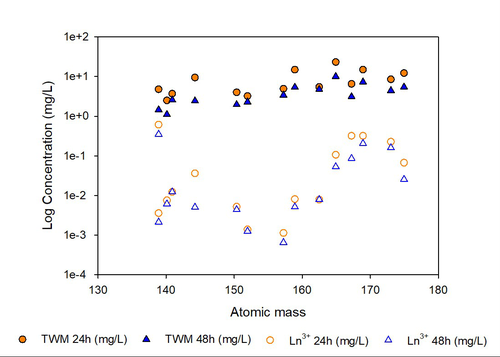
RICKWOOD Carrie J.
Recommendations: 0
Review: 1
Review: 1

Ecotoxicity of lanthanides to Daphnia magna: insights from elemental behavior and speciation in a standardized test medium
Lanthanide atomic mass and chemical behaviour in solution influence their solubility and ecotoxicity for Daphnia magna: Implications for risk assessment of aquatic organisms
Recommended by Patrice Couture based on reviews by Carrie J. Rickwood and 1 anonymous reviewerThe demand for lanthanides (LN) has seen a steady increase and is anticipated to continue to grow. Due to their unique properties, they have become essential in key components of new technologies, such as batteries, wind turbines, electronic components and other devices needed to facilitate energy transition away from fossil fuels. These elements are also increasingly used in a range of new technologies, including medical applications and telecommunication. In this context, the concentrations of lanthanides are expected to increase in freshwater environments (Gwenzi et al., 2018). Our limited knowledge about the risk that they pose to organisms limits our ability to develop guidelines for environmental protection. Research on this issue has so far been hindered by the peculiar properties of lanthanides, that tend to form insoluble precipitates when added in standard ecotoxicological test media (Blinova et al., 2018). This and other challenges of studying lanthanide toxicity were addressed in this in-depth study that leaves few stones unturned.
The study by Vignati and colleagues (2024) is the first to investigate the acute toxicity of all LN, with the exception of promethium, a radioactive element, on Daphnia magna, a model test species, following the ISO 6341 (2012) norm. The authors designed their study to generate data useable for the development of risk assessment guidelines for the LN series and to generate data-based recommendations for future studies on LN ecotoxicity. They exposed daphnids to nine to ten dilutions of all tested LN in a medium and carried out 48-hour acute immobilization assays. Initial and final pH was measured along with concentrations of LN in the test solutions sampled at various intervals by ICP-MS. This data allowed calculation of LN speciation, performed using VisualMinteq software. Effect concentrations were also calculated using different metrics based on initial (nominal), time-averaged or modelled LN3+ exposure concentrations.
In their multi-faceted investigation, the authors reported several observations that clearly contribute to a better understanding of the ecotoxicity of LN to aquatic organisms and provide useful advice for future studies, briefly summarized here. Proper characterization of exposure concentrations is a key in any ecotoxicological study. Their project shows that even for a short, 48 h exposure, LN concentrations decrease due to a combination of precipitation and, possibly, adsorption. The concentration decrease was inversely proportional to the LN atomic mass, which may reduce the analytical requirements for future studies using the same test medium. The addition of LN to the test medium also modified pH and a detailed hypothesis is formulated to explain this phenomenon that has implications for ecotoxicological endpoints. Conclusions on LN ecotoxicity drawn in this study are based on experimental data and on extensive thermodynamic speciation modeling. The values of EC50 presented in the study varied by several order of magnitude depending on the chosen exposure metric, underscoring the urgent need for consensus-building on this issue across the research community. The authors also provide a comparison of their conclusions on EC50 values for daphnids with the limited data available in the literature, further validating their data with cautions carefully laid out about experimental design. The paper concludes with a list of seven caveats that should be considered both for regulators who will want to use the data presented in the paper for environmental LN concentrations regulations and for future studies. These caveats highlight the importance of considering LN speciation and chemical behavior during ecotoxicity assays, their influence on exposure concentrations, and their importance for risk assessment. They also reiterate that since LN concentrations in filtered water collected in the field are not directly comparable to EC50 values derived from laboratory studies using total or free LN3+ concentrations, an effort must be made to harmonize the methods of LN concentration measurements in field and laboratory studies. Overall, this paper may be one of the most rigorous studies in the current literature about LN ecotoxicity in freshwater systems. In its approach, it sets a precedent for future studies aiming at generating EC50 values or other toxicological endpoints of inorganic contaminants. The paper, carefully reviewed by Carrie Rickwood and by an anonymous reviewer, is a major contribution towards our understanding of LN ecotoxicity.
References
Blinova, I., Lukjanova, A., Muna, M., Vija, H., & Kahru, A. (2018). Evaluation of the potential hazard of lanthanides to freshwater microcrustaceans. Sci. Tot. Environ. 642 :1100-1107. https://doi.org/10.1016/j.scitotenv.2018.06.155
Gwenzi, W., Mangori, L., Danha, C., Chaukura, N, Dunjana, N., Sanganyado, E. (2018). Sources, behaviour, and environmental and human health risks of high technology rare earth elements as emerging contaminants. Sci. Total Environ., 636:299-313. https://doi.org/10.1016/j.scitotenv.2018.04.235
ISO. (2012). Water quality — Determination of the inhibition of the mobility of Daphnia magna Straus (Cladocera, Crustacea) — Acute toxicity test (norm 6341). https://www.iso.org/standard/54614.html
Vignati, D.A.L., Martin, L.A., Poirier, L., Zalouk-Vergnoux, A., Fouque, C., Clément, B., Hissler, C., Cossu-Leguille, C. (2024). Ecotoxicity of lanthanides to Daphnia magna: insights from elemental behavior and speciation in a standardized test medium. Ver.3 peer-reviewed and recommended by Peer Community In Ecotoxicology and Environmental Chemistry. https://hal.science/LIEC-UL/hal-04302491v3